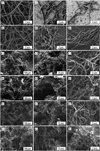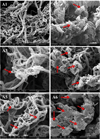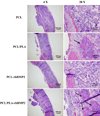Three dimensional electrospun PCL/PLA blend nanofibrous scaffolds with significantly improved stem cells osteogenic differentiation and cranial bone formation
- PMID: 27886552
- PMCID: PMC5181114
- DOI: 10.1016/j.biomaterials.2016.11.018
Three dimensional electrospun PCL/PLA blend nanofibrous scaffolds with significantly improved stem cells osteogenic differentiation and cranial bone formation
Abstract
Nanofibrous scaffolds that are morphologically/structurally similar to natural ECM are highly interested for tissue engineering; however, the electrospinning technique has the difficulty in directly producing clinically relevant 3D nanofibrous scaffolds with desired structural properties. To address this challenge, we have developed an innovative technique of thermally induced nanofiber self-agglomeration (TISA) recently. The aim of this work was to prepare (via the TISA technique) and evaluate 3D electrospun PCL/PLA blend (mass ratio: 4/1) nanofibrous scaffolds having high porosity of ∼95.8% as well as interconnected and hierarchically structured pores with sizes from sub-micrometers to ∼300 μm for bone tissue engineering. The hypothesis was that the incorporation of PLA (with higher mechanical stiffness/modulus and bioactivity) into PCL nanofibers would significantly improve human mesenchymal stem cells (hMSCs) osteogenic differentiation in vitro and bone formation in vivo. Compared to neat PCL-3D scaffolds, PCL/PLA-3D blend scaffolds had higher mechanical properties and in vitro bioactivity; as a result, they not only enhanced the cell viability of hMSCs but also promoted the osteogenic differentiation. Furthermore, our in vivo studies revealed that PCL/PLA-3D scaffolds considerably facilitated new bone formation in a critical-sized cranial bone defect mouse model. In summary, both in vitro and in vivo results indicated that novel 3D electrospun PCL/PLA blend nanofibrous scaffolds would be strongly favorable/desired for hMSCs osteogenic differentiation and cranial bone formation.
Keywords: 3D electrospun nanofibrous scaffold; Bone regeneration; Osteogenic differentiation; Polycaprolactone; Polylactic acid.
Copyright © 2016 Elsevier Ltd. All rights reserved.
Figures










Similar articles
-
Tailoring weight ratio of PCL/PLA in electrospun three-dimensional nanofibrous scaffolds and the effect on osteogenic differentiation of stem cells.Colloids Surf B Biointerfaces. 2018 Nov 1;171:31-39. doi: 10.1016/j.colsurfb.2018.07.004. Epub 2018 Jul 6. Colloids Surf B Biointerfaces. 2018. PMID: 30005288 Free PMC article.
-
Electrospun polycaprolactone 3D nanofibrous scaffold with interconnected and hierarchically structured pores for bone tissue engineering.Adv Healthc Mater. 2015 Oct 28;4(15):2238-46. doi: 10.1002/adhm.201500345. Epub 2015 Sep 1. Adv Healthc Mater. 2015. PMID: 26332611
-
Three-dimensional poly-(ε-caprolactone) nanofibrous scaffolds directly promote the cardiomyocyte differentiation of murine-induced pluripotent stem cells through Wnt/β-catenin signaling.BMC Cell Biol. 2015 Sep 3;16:22. doi: 10.1186/s12860-015-0067-3. BMC Cell Biol. 2015. PMID: 26335746 Free PMC article.
-
Effects of nanofibers on mesenchymal stem cells: environmental factors affecting cell adhesion and osteogenic differentiation and their mechanisms.J Zhejiang Univ Sci B. 2020 Nov.;21(11):871-884. doi: 10.1631/jzus.B2000355. J Zhejiang Univ Sci B. 2020. PMID: 33150771 Free PMC article. Review.
-
Design of electrospun nanofibrous mats for osteogenic differentiation of mesenchymal stem cells.Nanomedicine. 2018 Oct;14(7):2505-2520. doi: 10.1016/j.nano.2016.12.024. Epub 2017 May 26. Nanomedicine. 2018. PMID: 28554595 Review.
Cited by
-
Articular cartilage and osteochondral tissue engineering techniques: Recent advances and challenges.Bioact Mater. 2021 May 28;6(12):4830-4855. doi: 10.1016/j.bioactmat.2021.05.011. eCollection 2021 Dec. Bioact Mater. 2021. PMID: 34136726 Free PMC article. Review.
-
Synergistic Effect of Co-Delivering Ciprofloxacin and Tetracycline Hydrochloride for Promoted Wound Healing by Utilizing Coaxial PCL/Gelatin Nanofiber Membrane.Int J Mol Sci. 2022 Feb 8;23(3):1895. doi: 10.3390/ijms23031895. Int J Mol Sci. 2022. PMID: 35163814 Free PMC article.
-
An overview of 3D printed metal implants in orthopedic applications: Present and future perspectives.Heliyon. 2023 Jun 29;9(7):e17718. doi: 10.1016/j.heliyon.2023.e17718. eCollection 2023 Jul. Heliyon. 2023. PMID: 37456029 Free PMC article. Review.
-
Liquid Crystal Modified Polylactic Acid Improves Cytocompatibility and M2 Polarization of Macrophages to Promote Osteogenesis.Front Bioeng Biotechnol. 2022 Jun 17;10:887970. doi: 10.3389/fbioe.2022.887970. eCollection 2022. Front Bioeng Biotechnol. 2022. PMID: 35782509 Free PMC article.
-
Electrospun Icariin-Loaded Core-Shell Collagen, Polycaprolactone, Hydroxyapatite Composite Scaffolds for the Repair of Rabbit Tibia Bone Defects.Int J Nanomedicine. 2020 May 1;15:3039-3056. doi: 10.2147/IJN.S238800. eCollection 2020. Int J Nanomedicine. 2020. PMID: 32431500 Free PMC article.
References
-
- Cabraja M, Kroppenstedt S. Bone grafting and substitutes in spine surgery. J Neurosurg Sci. 2012;56:87–95. - PubMed
-
- Morelli S, Salerno S, Holopainen J, Ritala M, De Bartolo L. Osteogenic and osteoclastogenic differentiation of co-cultured cells in polylactic acid–nanohydroxyapatite fiber scaffolds. J Biotechnol. 2015;204:53–62. - PubMed
-
- Heymer A, Bradica G, Eulert J, Nöth U. Multiphasic collagen fibre–PLA composites seeded with human mesenchymal stem cells for osteochondral defect repair: an in vitro study. J Tissue Eng Regen Med. 2009;3:389–397. - PubMed
-
- Khan Y, Yaszemski MJ, Mikos AG, Laurencin CT. Tissue engineering of bone: material and matrix considerations. J Bone Joint Surg. 2008;90:36–42. - PubMed
Publication types
MeSH terms
Substances
Grants and funding
LinkOut - more resources
Full Text Sources
Other Literature Sources
Medical

